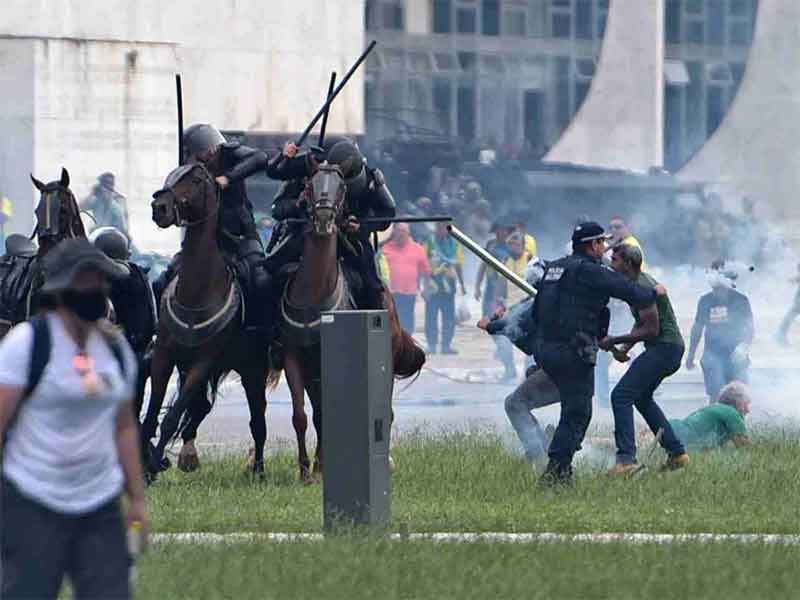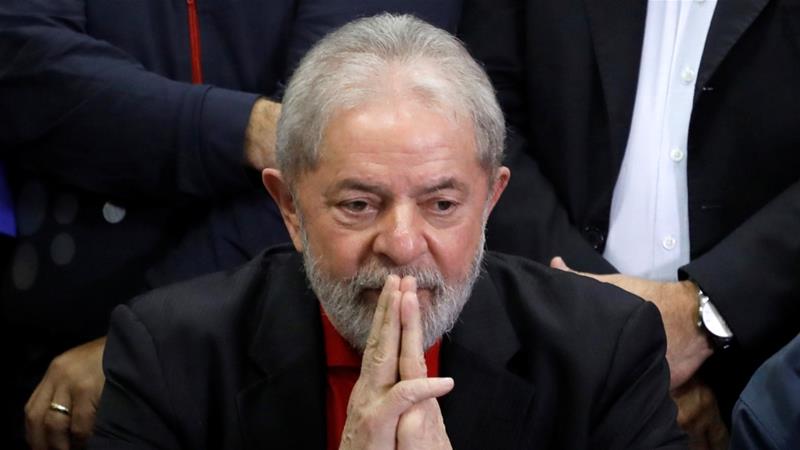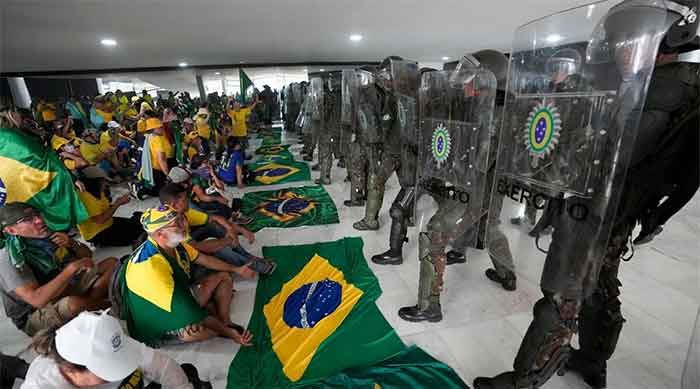
Social movement research has generally excluded right wing movements as a subject of its research, as Nelson Pichardo has highlighted in his critique of the ‘New’ Social Movement (NSM) paradigm and its theorists, who have been ideologically biased towards movements originating from the ‘left’ (Pichardo 1997). Recently, however, there has been some significant exploration of contemporary right-wing movements. This essay will look at the typologies of right-wing movements created by some of the scholars focusing on this area of study, and attempt to apply mainstream social movement theory to the case study of a right-wing protest in Brazil in 2023, when supporters of ex-president Jair Bolsonaro stormed the Three Powers Plaza in Brasilia, the capital of Brazil.
A major chunk of the scholarship on right wing movements have been geared towards American politics and contexts, although some work has been focused on India and Latin America. This paper has taken into account the discussion on movements in the United States, such as the Ku Klux Klan or the anti-abortion March for Life movement, but attempted to situate it in a more global context.
Typology of Right-Wing Movements: what constitutes one?
At the outset, it is important to understand the difference between what constitutes the ‘left’ and the ‘right’. This paper will predominantly refer to Italian philosopher Norberto Bobbio’s demarcation between the two, which relates to their contrasting attitude towards equality among human beings. The left is principally egalitarian, working towards achieving equality for groups heretofore lacking it politically, socially or economically. The right, on the other hand, emphasizes certain inequalities as necessary for societies to work, such as racial, gendered or other such hierarchies that exist in the social, political and economic order (Virchow 2017, 620).
While the left and the right are often considered to be on opposing ends of the political spectrum, such a reductionist view does not capture the full nuance of the spectrum. A black and white distinction between the two is an incorrect assumption, and Herbert McClosky and Dennis Chong have recognized this complexity by stating that the left and the right may differ significantly in relation to their political beliefs and ideologies but apply similar tactics to achieve their respective goals (McClosky and Chong 1985). Violent extremism, for example, cannot be solely associated with the right wing, as the left also has its extremist groups, such as the armed Naxalite groups in India, or the Red Army Faction in West Germany.
With respect to a typology or general framework of right-wing social movements, a relatively simpler one has been created by Kathleen M. Blee and Kimberly Creasap (Blee and Creasap 2010), where they use the label ‘conservative’ for movements that support patriotism, free enterprise capitalism, or a traditional moral structure, and the term ‘right wing’ for movements that focus directly on race, ethnicity or religion, and promote violence as a primary goal. Conservative movements, they claim, do not use violence frequently as a tactic during demonstrations. Along with this, they use the term ‘rightist’ as an umbrella term that encompasses both kinds of movements. The authors promptly point out that this theoretical framework is not that simple in practice; a strict distinction between the supposed conservative and right-wing movements does not exist, since a movement can have elements of both. Anti-abortion protests which are conservative in their desire to uphold a traditional moral order, such as the March for Life protest in the U.S., had religious underpinnings. Therefore, this typology is insufficient to take into account the nuanced characteristics of right-wing movements.
Fabian Virchow has done a more comprehensive analysis on what kind of movements are subsumed under the term ‘right wing movements’ (Virchow 2017). He acknowledges that there is a variation between different rightist groups, with fascists being on the extreme end of the political spectrum, campaigning for a racially purified state, such as the Ku Klux Klan in the United States, while some conservative movements are less violent. The agendas of right-wing movements also vary, from singular issues to more complex agendas. Singular issue protests are akin to the anti-refugee protests held in Dover in March 2023, which have flared up due to the large number of Ukrainian refugees flowing into European states, including Ireland (Gannon 2023).
Meanwhile, movements such as the American Tea Party movement which focuses on cutting taxes, debt and spending, repealing ex-President Barack Obama’s health care plan which makes healthcare more affordable, also known as The Affordable Care Act, and advocating for a more constitutionally limited government have multiple agendas. Certain notions of the Tea Party members are underlined by religious sentiments as well, reflecting in their support for the anti-abortion movement (Melber 2011). Therefore, there are a variety of agendas that bring forth right wing movements, and the tactics they use are similar to that of left-wing movements, ranging from the use of social media, public demonstrations, to more violent acts.
Is there a theory of right-wing movements?
Rory McVeigh, a scholar who has extensively worked on theorizing the rise of the Ku Klux Klan, a white supremacist organization in the United States, examined the existing and dominant theories of social movements in his work (McVeigh 1999). The dominant theories of the 1950s and 1960s characterized social movements as arising out of preexisting structural issues, including a lack of political freedom, a fragile economic situation, discrimination on the basis of race, religion, gender, sexual orientation, etc. This notion was encompassed in Smelser’s Structural Strain Theory (“Social Movements” 2016). Other theorists, such as Davies and Gurr, discussed the role of ‘deprivation’ in the initiation of movements, arguing that when a group of people feel deprived of a specific good, resource or service, they are likely to protest. However, the deprivation theory failed to explain why in many cases deprivation fails to ignite a protest (Sen and Avci 2016). In the 1970s and 1980s, new theories such as the Resource Mobilization Theory gained traction in an attempt to explain that grievances alone are not enough to spark a protest; they need to go hand in hand with the accessibility of resources such as time, money, energy, labour, etc. (“Social Movements” 2016). This theory has been complemented by theories that focus on how movements exploit openings in the structure of political opportunities (McVeigh 1999).
McVeigh also discusses how protest participation was presumed to be irrational by the theorists of 1950s and 1960s, but this stance was changed and mostly settled by later theories, as “Resource Mobilization theory challenged prevailing notions, arguing that social movements are a perfectly rational form of political activity for groups lacking access to more traditional lines of political influence” (McVeigh 1999, 1462). He brings in a very interesting dimension to social movement theory – that scholars are reluctant to assume that the participants of conservative or right-wing movements are rational. His analysis of dominant social movement theory is particularly useful for this paper, as he discusses how conservative movements do not fit very well within the frameworks of Resource Mobilization Theory or the Political Opportunities model, giving the example of white supremacist organizations that sprang up during and after the Civil Rights Movement in the United States in the 1950s and 1960s. The political opportunities at the time were more favourable to the black insurgency than to the white supremacist organizations who desired the preservation of a racially segregated society.
Therefore, to extrapolate from his analysis, the most important objective of a conservative movement is to preserve or reestablish a certain social, political or economic order. This is in stark contrast to movements originating from the left, which aim at expanding on rights and transforming the prevailing order. He has articulated his theory of conservative or right-wing movements as the Power Devaluation Theory, where mobilization occurs when a group’s power is devalued and they feel threatened by societal changes (Irons 2011). It is interesting to note that in leftist movements there are preexisting grievances, but conservative movements are borne out of new grievances.
A Case study – the Bolsonarists
One of the most recent right-wing protests that took place was in Brasilia, the capital of Brazil, on 8th January, 2023, when supporters of the ex-President Jair Bolsonaro stormed the Congress and other buildings, demanding that the military take over the government (Bowman 2023). These supporters, claiming to be ‘Bolsonarists’, attacked the Praça dos Três Poderes or Three Powers Plaza, which is the headquarters of the Legislative branch, the Executive Branch, including the Presidential Palace, and the Supreme Court.
The protestors were discontent with the recent election held in October 2022, and the victory of the now President Luiz Inacio Lula da Silva. The cause for the protests was the false claim regarding fraudulent electronic voting system, which was encouraged by Bolsonaro himself, and therefore the protestors were agitated at his loss (Al Jazeera 2023). The protestors blocked roads, set vehicles on fire, and vandalized the Three Powers Plaza during the demonstrations. Many arrests were made, and leaders of several states, including the Indian Prime Minister Narendra Modi condemned the vandalism on Twitter. Lula da Silva accused Bolsonaro of instigating the protestors over social media, however Bolsonaro refuted these claims.
To situate this protest into the theoretical framework provided above, this would not be a right-wing protest as defined by Blee and Creasap since it is not aimed against a particular racial, religious or ethnic group. The target of this protest was to stop Lula da Silva from serving as President, with the larger context of Bolsonaro’s ideology leaning towards the right. Deepanshu Mohan and Abhinav Padmanabhan, in their book, sketch out Brazil’s political scenario prior to the 2022 elections (Mohan and Padmanabhan 2022). Lula was elected President in 2002, and re-elected for a second term in 2006. He had a more left leaning ideology, owing to his background as labour union leader, and representing the Workers’ Party in the elections. His approach to governance was welfare based, with a focus on government spending and increasing job opportunities. However, subsequently, during Dilma Rousseff’s tenure, there was wide scale corruption, and the country suffered economically. This paved the way for Bolsonaro’s popularity, who advocated an anti-left government and appealed to Brazil’s Christian traditions. His brand of populism won him immense support, and he served as the Brazilian President from 2019 to 2022.
It is interesting to note that while the 2023 protest was anti-government, or specifically, against Lula’s rule, there are undeniable religious elements in Bolsonaro’s ideology. His re-election campaign emphasized his views against abortion, LGBTQ+ rights, and intent to restrict freedom of religion, along with advocating a more open market economy in the country (Council on Foreign Relations 2023). Therefore, his proponents, who may support any or all his views, do not fall neatly within the conservative/right wing binary, highlighting once more that the strict distinction between the two is very difficult to make.
This protest does, however, somewhat relate to McVeigh’s Power Devaluation theory. The demonstrations in support of Bolsonaro only began once he lost the elections, intensifying to a violent stage only after Lula’s inauguration in January when Bolsonaro was truly out of the position of power. This is not to say that political opportunities or resources did not have a hand to play in allowing the protestors to reach the Plaza. There was a mystifying lack of security on the premises, even though the offices in the Plaza were closed on that day since it was a Sunday, providing for a good opportunity for the protestors to attack the buildings. Lula appointed a new head of security in the Federal District to rectify the situation (Bowman 2023).
Therefore, this was a protest originating from the ‘right’ of the political spectrum, although its stance on the right is undecided. Lula called the protestors ‘fascists’ in one of his comments, saying “These vandals, who we could call fanatical Nazis, fanatical Stalinists … fanatical fascists, did what has never been done in the history of this country” (Al Jazeera 2023). However, according to Fabian Virchow’s definition, rightist fascism is related to advocating for a racially purified nation, which has not seemed like the goal of the protestors (Virchow 2017, 621). Therefore, the definitional ambiguity of what constitutes the right is clear in the responses of political leaders as well. It can, however, be asserted that this protest used violence as a tactic and adhered to elements of the right in its quest to preserve a certain political order.
Conclusion
In summation, this paper attempted to explore the oft neglected social movement research on right wing movements. Certain difficulties pertaining to the divergence in definitions of terms such as ‘conservative’ and ‘right wing’ made it more complex to analyze protests originating from the right, such as the Bolsonarists protests in Brasilia in January of 2023. However, as scholars, it is important to research rightist protest movements as well, in order to have a diverse understanding of how different types of social movements evolve.
References
Blee, Kathleen M., and Kimberly A. Creasap. 2010. “Conservative and Right-Wing Movements.” Annual Review of Sociology 36: 269–86. https://www.jstor.org/stable/25735078.
“Bolsonaro Supporters Storm Key Government Buildings in Brazil.” 2023. Accessed May 6. https://www.aljazeera.com/news/2023/1/8/bolsonaro-supporters-storm-government-buildings-in-brazil.
“Bolsonaro vs. Lula: What’s at Stake in Brazil’s 2022 Election.” 2023. Council on Foreign Relations. Accessed May 6. https://www.cfr.org/in-brief/bolsonaro-vs-lula-whats-stake-brazils-2022-election.
Bowman, Emma. 2023. “Security Forces Regain Control after Bolsonaro Supporters Storm Brazil’s Congress.” NPR, January 8, sec. Latin America. https://www.npr.org/2023/01/08/1147757260/bolsonaro-supporters-storm-brazil-congress-lula.
Dena, Lal. 2023. “Hindutva and the Question of Who Owns India.” The Wire. Accessed May 6. https://thewire.in/communalism/hindutva-and-the-question-of-who-owns-india.
Gannon, Colin. 2023. “Why Are Ireland’s Anti-Refugee Protests Erupting Now? Look across the Irish Sea.” The Guardian, March 21, sec. Opinion. https://www.theguardian.com/commentisfree/2023/mar/21/ireland-anti-refugee-protests-far-right-uk-politics.
Irons, Jenny. 2011. “The Rise of the Ku Klux Klan: Right-Wing Movements and National Politics (Review).” Social Forces 89 (3): 1059–60. doi:10.1353/sof.2011.0004.
Islam, Shamsul. 2016. “Babasaheb Ambedkar’s Scathing Attacks on Hindutva and Hindu Rashtra.” Sabrang India. April 14. https://www.sabrangindia.in/article/babasaheb-ambedkars-scathing-attacks-hindutva-and-hindu-rashtra.
Khare, Harish. 2023. “After Seven Years of Modi and Shah, the RSS’s Fall from Grace Is Total and Complete.” The Wire. Accessed May 6. https://thewire.in/politics/rss-mohan-bhagwat-bjp-modi-covid-19.
McClosky, Herbert, and Dennis Chong. 1985. “Similarities and Differences between Left-Wing and Right-Wing Radicals.” British Journal of Political Science 15 (3): 329–63. https://www.jstor.org/stable/193697.
McVeigh, R. 1999. “Structural Incentives for Conservative Mobilization: Power Devaluation and the Rise of the Ku Klux Klan, 1915-1925.” Social Forces 77 (4): 1461–96. doi:10.1093/sf/77.4.1461.
Melber, Ari. 2011. “The Tea Party’s Social Agenda.” POLITICO. April 13. https://www.politico.com/story/2011/04/the-tea-partys-social-agenda-053013.
Mohan, Deepanshu, and Abhinav Padmanabhan. 2022. “How Jair Bolsonaro Introduced a Populist Right-Wing Movement to Brazil – like the One India Has Too.” Text. Scroll.In. October 10. https://scroll.in/article/1034421/how-jair-bolsonaro-introduced-a-populist-right-wing-movement-to-brazil-like-in-india.
Pichardo, Nelson A. 1997. “New Social Movements: A Critical Review.” Annual Review of Sociology 23: 411–30. https://www.jstor.org/stable/2952558.
Publisher, Author removed at request of original. 2016. “21.3 Social Movements,” April. https://open.lib.umn.edu/sociology/chapter/21-3-social-movements/.
Sen, Anindya, and Omer Avci. 2016. “Why Social Movements Occur: Theories of Social Movements” XI Spring: 125–30. http://www.beykon.org/dergi/2016/SPRING/2016XI.I.10.A.Sen.pdf.
Virchow, Fabian. 2017. “Post-Fascist Right-Wing Social Movements.” In The History of Social Movements in Global Perspective, edited by Stefan Berger and Holger Nehring, 619–46. London: Palgrave Macmillan UK. doi:10.1057/978-1-137-30427-8_21.
Anika Vijapur is pursuing graduate course of Research in International Relations at Shiv Nadar University, NCR, Delhi. She can be reached at: [email protected]















































